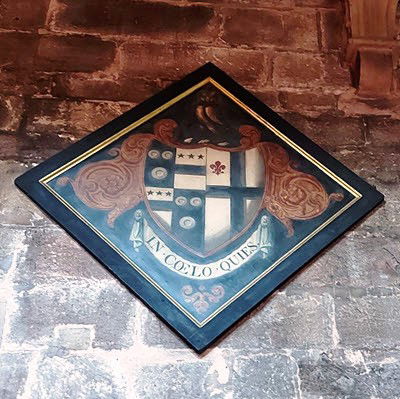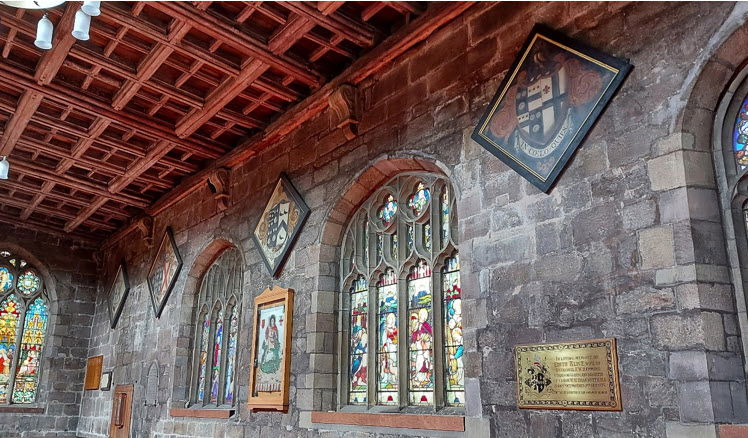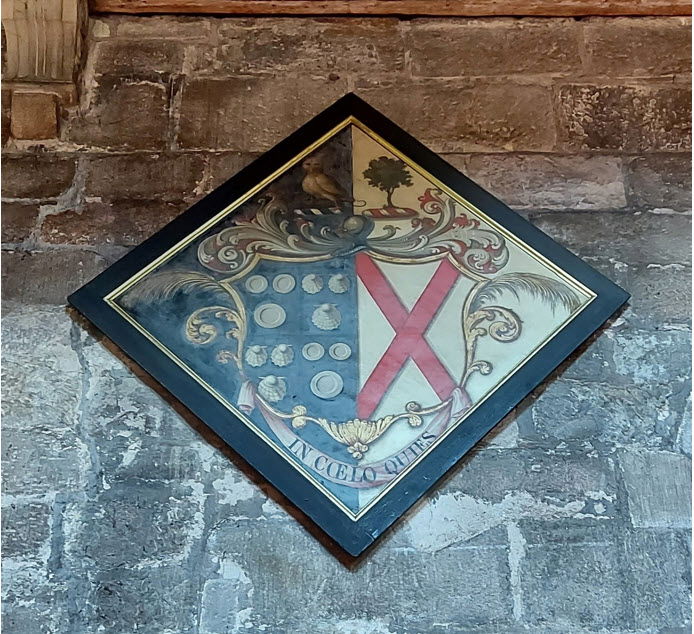St Wilfrid’s Church Standish

A study of the Funeral Hatchments at St Wilfrid’s Church Standish
by Jim Meehan

The four funeral hatchments on the north wall of the church
Funeral Hatchments were a feature of the early nineteenth century. They were designed to be carried at the front of funeral processions. They were not intended to be permanent memorials and were usually made of canvas on a wooden frame. They were placed on the house front, then carried to the church and usually left there on display for a time after the funeral. Hatchments depict the full armorial bearings of the deceased. The term hatchement is a corruption of achievement, as in an Achievement of Arms which includes the shield, crest, motto, and supporters. The hatchment for a married person will show the male arms on the dexter side (right, when viewed from behind) and the female on the sinister side. They have a black background on the side of the partner who has died. If the whole hatchment is black it depicts the death of a widow or widower. There are four hatchments on display in St Wilfrid’s. Their scale is impressive, and photographs do not do them justice. The largest is approximately seven foot high by seven foot wide. Those relating to the Standish family were previously preserved in the parvise (room above the porch).[i] Later they were hung in the belfry away from public view.[ii] They were moved to the wall of the north aisle sometime after 1972. We will look in more detail at the historic figures they represent in chronological order.
Edward Towneley Standish - Lord of Standish manor

Edward became lord of the manor in 1778 following the death of his mother Cecilia Towneley. She had married into the Towneley family and outlived her husband. Her first son inherited Towneley manor near Burnley. Edward was her second son and inherited Standish manor, adopting the surname as he did so. He died in 1807 aged 66. Edward made numerous changes to Standish Hall and the surroundings, filling in the moat and landscaping the park around the house. He also renegotiated the estate mineral leases paving the way for an expansion of coal mining in the area. The hatchment shows the coat of arms of Towneley quartered with Standish on the left impaling the Eccleston coat of arms on the right. He married Anne Eccleston who was a member of the wealthy family who owned land around Eccleston and Scarisbrick, and what would become Southport. Both sides of the hatchment are black indicating Ann had died before Edward. They had no surviving children. The hatchment motto reads “In Coelo Quies” which translates as “in heaven there is peace”.
Anastasia Strickland Standish – The Lady of Standish Manor

Anastasia was briefly the lady of Standish manor. Her husband Thomas Strickland Standish inherited the title from Edward, his uncle, in March 1807. Anastasia died less than three months later on 22 June aged 38. Her birth name was Lawson, and she grew up at Brough Hall near Catterick in Yorkshire, where there is a memorial to her in the local church. Her son Charles went on to hold the Standish title until 1863. She was also succeeded by two daughters. Sadly one of them, also named Anastasia, died just five months after her in 1807 at the tender age of 10. Thomas inherited the title and lost his wife and daughter in the same year. The hatchment shows the coat of arms of Strickland quartered with Standish on the left, impaling the Lawson family coat of arms on the right. The motto on the hatchment is the same as the other Standish family members and translates as “in heaven there is peace”.
Thomas Strickland Standish – Lord of Standish Manor

Following the death of Anastasia, his first wife, Thomas married Catherine Gerard in October 1808. He was Lord of manor until his death in 1813 aged 50. The hatchment shows the coat of arms of Strickland quartered with Standish impaling Gerrard. Catherine was the daughter of Sir Robert Gerard. Thomas was a Strickland from Sizergh Castle in Cumbria. His mother Cecilia Standish had married into the family. He inherited the title when his uncle Edward Towneley Standish died without children in 1807. Like his uncle before him he adopted the Standish name. The hatchment has the same motto as his first wife’s hatchment. Thomas was the first of the Standish family to be interred under the Standish Chapel, his predecessors being interred on the north side of the Rector’s chancel.[iii] His portrait is below.
Sir Robert Clayton – the last Baronet of Adlington

This hatchment shows the Clayton coat of arms on the left impaling Baldwin on the right. The red hand in the centre of the shield denotes the fact that the Claytons held a hereditary Baronetcy. Robert was married to Christophora Baldwin the daughter of a local Rector. Robert led an interesting life. He was an army major and fought in the American Civil War. He was involved in notable battles and was captured twice by American forces. He returned to England in 1786 when he married Christophora. He did not inherit the Baronetcy until he was 82. He declined moving to Adlington Hall which was the seat of the family estate but remained in the Larches near the Boar’s Head. His niece and her husband stayed at the Hall. He died in 1839 at the age of 93 and is buried in the churchyard. He had no children making him the last Baronet of Adlington. The motto on the hatchment translates as “integrity rather than riches” which may explain his reluctance to adopt the trappings of his title. He is buried in the churchyard alongside Christophora. His portrait is below.


Sir Robert Clayton
Last Baronet of Adlington
[i] WF Price, Notes on the Parish Church of St Wilfred Standish, 1904 p258
[ii]J Fairhurst, St Wilfrid’s Church Standish, Standish Local History Group, 1972
[iii] Rector Perryn’s Notebook, December 4, 1813